Tannins, tea and trees

We come across tannins in various foods and drinks. They contribute to the taste of a cup of tea, a mug of coffee or a glass of wine. Tannins contribute an astringent taste - a sensation of “dryness” in the mouth. Tannins are molecules made by plants - they are complex polyphenols built from several phenolic molecules. A phenol is made from a hexagon-shaped carbon ring with one or more hydroxyl groups (-OH) attached to it (see diagram) .
.
They are generally water-soluble molecules and they can combine with proteins, cellulose, pectins etc. Tannins are generally stored in the vacuole of plant cells (as are various oils, resins, crystals of calcium oxalate etc). Collectively, these materials are sometimes referred to as ergastic substances.
The word tannin comes from the german 'tanna' - for oak. Tannins derived from oak trees were used to make leather from animal hides. The tanning of leather has a long history, dating back some 5000 years (in Egypt).
Tannins are common in leaf tissues - particularly in the cells of the upper epidermis (on the top surface of a leaf). Scale leaves of buds are often rich in tannins. It is thought that the tannins reduce the palatability/"tastiness" of the tissue thereby offering protection against herbivores. In the roots, tannins may be present again just below the epidermis offering some protection against the entry of pathogens. The tannins are also found in the the heartwood (sometimes referred to as the duramen), it is the dead, central wood of trees. Tannins make it dark in colour and sometimes aromatic (as in Cedar).

The growth and height of a tree relies in part on the ‘quality’ of the wood making up its stem. The mechanical properties of the wood are due to the make-up of the matrix of cellulose, hemicelluloses, and lignin - that, in turn, make up the xylem. However, decay by microorganisms can reduce its mechanical strength, so many tree species seek to increase the durability of their wood; and this is determined, in part, by the presence of tannins.
The formation and accumulation of tannins is linked to the conversion of sapwood into heartwood. Sapwood is the outer and youngest part of the wood, it lies nearest the bark. It contains the working xylem vessels (that conduct the water to the leaves) and living non-lignified cells. The concentration of tannins in sapwood is generally low, so it is prone to decay. The heartwood has no living cells but it is richer in tannins, which make it much more resistant to decay. The tannins are made by the living, non-lignified cells as the sapwood transforms into heartwood - just before they die.
The exact chemical nature of the tannins and the quantity depends on the species being considered, but oak and sweet chestnut that are rich in tannins are also known for the durability of their wood. Whilst the microbial toxicity of the tannins is not to be compared to commercial bacteriocides or fungicides - the sheer quantity of tannins affords protection against attack. The tannins / polyphenols may represent 10% or more of the dry mass of the heartwood.
There is also evidence that tannins protect certain trees species from being 'harvested' by beavers. Cottonwoods with a high tannin content are 'avoided' by beavers - as are aspens with high tannin levels.
Comments are closed for this post.

I’ve found all this information about tannins absolutely fascinating.
Natural plant dyers of cellulose fibres use tannin when preparing their fabric for dyeing as it is a premordant used to improve the absorption of alum, which is a necessary mordant for cellulose fibres.
It can also be used on its own as a natural plant mordant as well as dye for fabric, the most common form of tannin used being oak galls.
Mary Lemmon
21 September, 2022